Offering the best products and services might not suffice without enough online visibility. As SEO drives over 93% web traffic, coming up with solid SEO strategies is imperative for business survival.
According to a survey, about 68% of consumer journeys start online. The internet has rendered accessing information a matter of mere seconds. While it has made it easier for consumers to decide which business they want to transact with, it has, at the same time, shortened the decision-making process by a significant margin. Hence, ranking well on the SERPs has become crucial for businesses to thrive.
People tend to focus on the first few entries of the SERPs. The first ranking page gets an average of 33% clicks of all the organic traffic. The second page and the third page get a CTR of 18.7% and 10.2%, respectively. Hence, ranking on the first page is crucial.
Worry not. Here, we are going to discuss the best strategies for search engine optimization that will help you land on the first page.
What are SEO Strategies?
SEO strategies are plans that follow ethical practices and aim to promote content to attain better visibility in organic search results. It entails an array of techniques like link building, guest posting, content- optimization, mobile responsiveness, page speed time reduction, etc.
These strategies are instrumental in exposing brands to the public eye. They help businesses expand the market and meet target audiences online. They assist in brand building, reputation establishment, and sales enhancement.
Why are SEO Strategies Important?
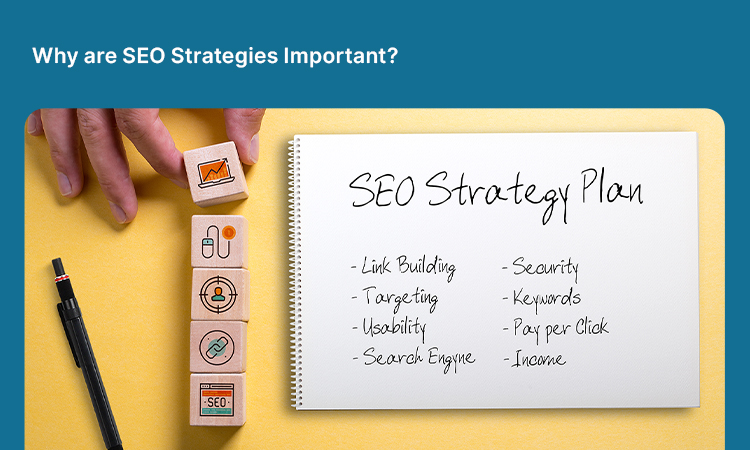
Creating a website is not a big deal, but making it rank is! This is exactly where SEO strategies come in. These strategies entail optimizing websites keeping search engine guidelines in mind. A solid SEO campaign has an immense positive effect on a brand’s business growth.
Let’s walk you through the various benefits that robust SEO strategies render to a business;
- Better online visibility: Effective search engine optimization strategies position a brand in the front and center of search results, rendering company websites better online visibility. A very well-optimized website can even rank on the first page of the SERPs.
- Higher organic Search Traffic: SEO leads organic traffic to your website. Resorting to good SEO strategies that work for your website will boost the inflow of such traffic. This is unpaid traffic that your website gets because of its quality of optimization.
- Cuts through the Competition: The more traffic your website gets, the lesser the volume of it goes to our competitors. Hence, formulating robust SEO strategies is important to beat your competitors.
- Boosts Brand Awareness: With higher positioning on the search engine results pages, people get to know more about your brand. It can help conversions as your brand’s name gets instilled in people’s minds. So, the next time they think about purchasing something that you sell, they are likely to consider you.
- More ROI: Better geo-targeting and brand positioning boost potential customer footfall, resulting in more conversions.
3 Best SEO Strategies That Drive Results
Ranking on the first page is not an easy deal. There are millions of webmasters trying to rank on the SERPs just like you are. SEO requires more than just pasting articles on the content management systems. There are a plethora of things to take care of in order for the search engines to think your website is worthy!
The good news is a good SEO formula is not rocket science. You can do it if you keep a few simple things in mind. There are 3 specific segments of search engine optimization. They are— on-page SEO, off-page SEO, and technical SEO.
So, let’s walk you through the important SEO strategies that will help you rank on the first page of Google;
- On-Page SEO Strategies: Get More Organic Traffic on Your Website
On-page SEO optimization denotes the sum total of all SEO activities that are done right on the website. It comprises several factors like content, keyword density, internal and external links, website images, etc.
Let’s take a look at all the on-page SEO strategy upgradation you can do to bolster your website’s search traffic;
- Align Content With Search Intent
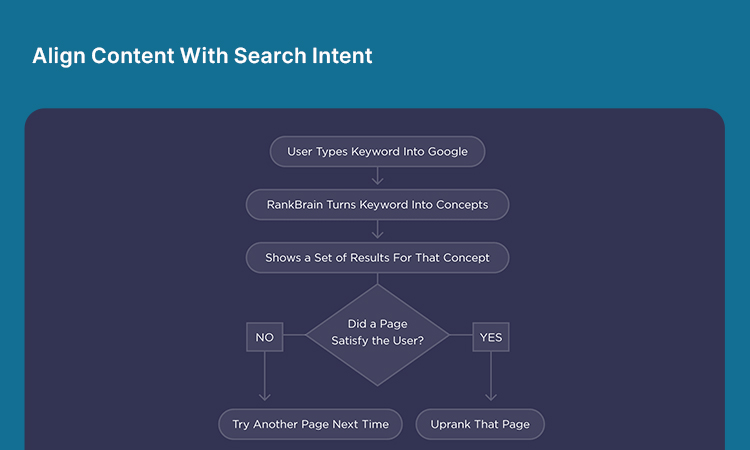
After Google’s latest algorithm update, aligning content with search intent has become crucial. Keyword optimization alone won’t cut it because of Google’s RankBrain. It is an AI that understands how users are reacting to certain content and revises results according to that.
There are 4 basic types of search intent. They are informational, commercial, navigational , and transaction. Ensure that the content you are trying to rank for matches with the search intent of the users.
For example, the keyword ‘best SEO strategy’ is informational in nature. So when we create content using this keyword, we have to understand the user’s search intent behind searching with the keyword. Here, the user is obviously trying to acquire more knowledge on optimizing websites. Hence, in this instance, if we create commercial content and try to sell something, this article is bound not to rank.
Search Intent Alignment Checklist
- analyze keyword intent
- Use long-tail keyword
- Tailor content to ensure relevance and value
- Use Keywords Wisely (Do not Over Optimize)
Keyword usage and its volume have long confused the general mass. When it comes to keywords, there are so many questions going on in the mind of a webmaster. Questions like;
- Should I use a paid keyword research tool?
- Should I use broad keywords?
- Should I use long tail keywords to address specific search queries?
The answer to all the search queries is an emphatic YES.
Suppose you are writing on ”How to do Paid Search Ads for Doctors?”. In this case, including broad-spectrum keywords like ” Doctor PPC” and specific long tail keywords like ”How to do Paid Ads for Doctors?” are necessary.
The former targets a broad spectrum of audiences who are looking at PPC for doctors, and the latter who are specifically looking for ways to optimize the paid ad campaign for themselves.
There is another common question regarding keywords when it comes to SEO strategies, i.e., what should the volume of the keywords be?
A decade back, a volume of 2% keyword density was considered good. However, with the recent core algorithm update of Google, keyword density optimization has become less important.
Using the main keyword only a few times in the body can do the job if the content has related words and matches the search query of the users.
As far as keyword strategy is concerned, under-optimization is less of a crime than over-optimization. Never force keywords into the content. Also, using related keywords helps search engine rankings.
If you are thinking about how to choose topics for your website blog posts, you can always bank on Google to help you find related keywords. Just follow what people are searching, and you are likely to get a clear idea of which words to use for ranking on the search engine results pages.
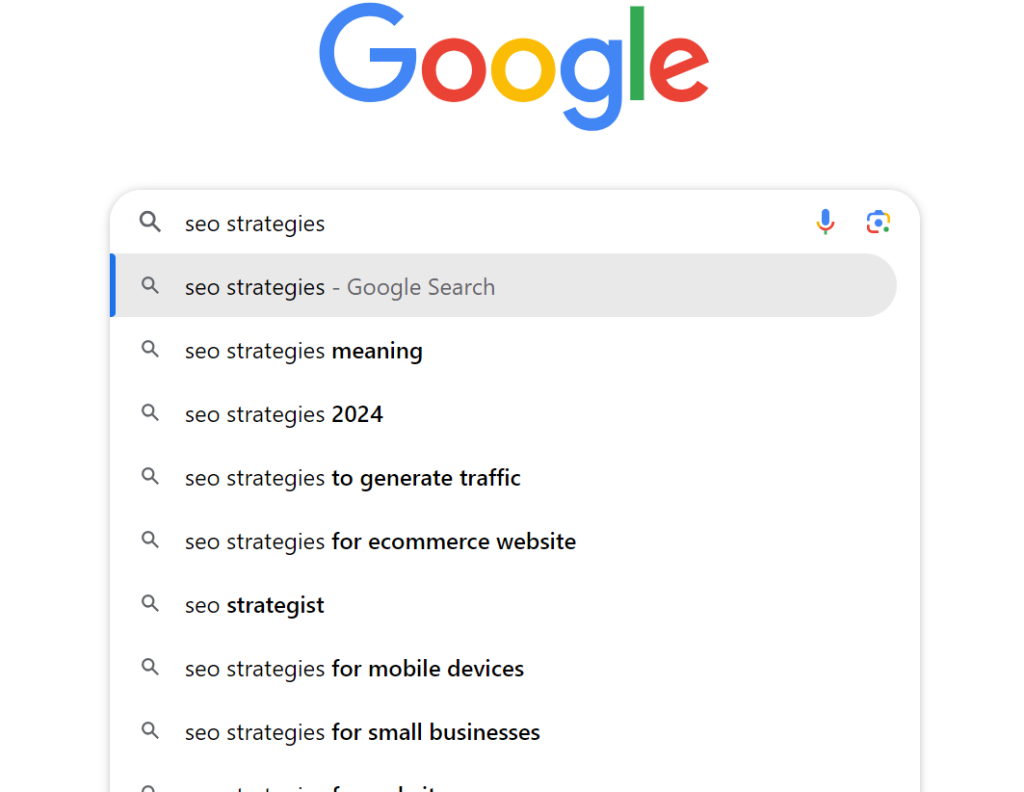
Keyword Optimization Checklist
- Use premium keyword SEO tools
- Follow the Google search pattern to find relevant keywords
- Try to choose keywords with less keyword difficulty and higher search volume
- Optimize content with long tail keywords
- Do not engage in keyword-stuffing
- Lastly, trust the process!
- Punctuate Content With High-Quality Internal and External Links
Internal and external linking are important if you want an unbeatable SEO strategy!
Internal links mean when you hyperlink any of your website’s web pages with another. These links help distribute domain authority across multiple web pages, which translates to better rankings.
External links, as opposed to internal ones, are outbound links that point to other websites. It is a Strategic SEO plan for the search engine bots to find your website credible.
Let us explain. When you link to another website, the web crawlers get a chance to verify the information on your page. This helps them decipher that your website is credible, resulting in a better ranking on the SERPs.
Whether you are interlinking or placing external links, one thing to keep in mind is the anchor text. As Google prioritizes the best user experience, you must make sure that the anchor text that directs to other sites is related.
Also, the point of relevancy is crucial here. While doing internal or external linking, ensure that you are keeping things relevant and not doing it just because someone told you to! Remember, the search engines are smart enough to understand unconnected practices.
Internal & External Linking Checklist:
- Use relevant anchor texts
- Link to domains with high domain authority (at least 40+)
- Do internal linking between relevant/ related pages
- Website Images Require Optimization
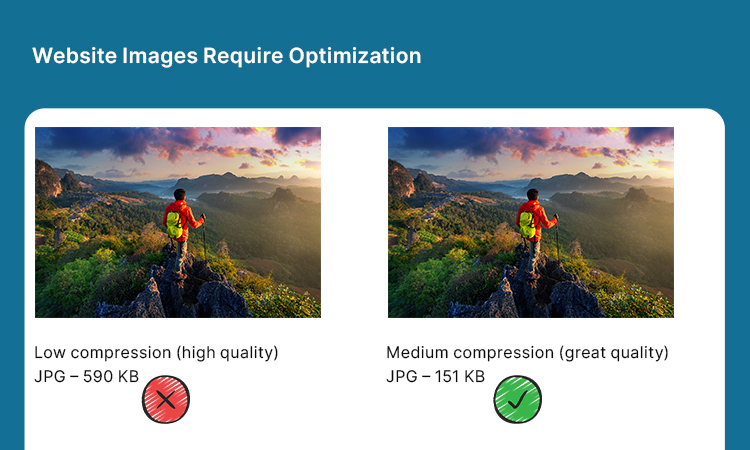
One image is worth a thousand words!
Image optimization is a powerful strategy that helps websites rank better on Google searches. As images help hold the visitors’ attention, search engines deem images as one of the core components of the on-page SEO strategy. Enriching a website with images heightens user engagement and strengthens the EEAT signals.
Images can make or break your brand! Yes, a staggering 67% of people decide your website’s worth based on the quality of the images.
Hence, be sure to upload high-resolution images that do not pixelate when zooming, as visitors associate the quality of images directly with the quality of your business.
Another important practice in connection to image SEO is to add alt texts to the images. You can add these texts right below the images where there is a space for the alt texts. This helps search engines understand what the image is about.
With good quality images and relevant alt texts, you can rank on Google’s image results along with ranking on the SERPs.
Another fail-safe way is to create an image sitemap and submit it to Google. It is much like the XML file of your website. An Image sitemap tells Google about the images present on your website which increases your website’s visibility on the image search results.
Image SEO Checklist:
- Upload high quality images
- Use GZip compression
- Create and submit an image sitemap
- Optimize images with alt texts
- Use responsive images to fit the screen size of any device
- Optimize image placement
- Content is Always the KING!

Content marketing is a sure shot way to attract visitors to your website. When SEO is concerned, the scope of content marketing is limited to landing pages, blog posts, and social media content. Nonetheless, these are powerful ways if you harness them right.
Creating high quality content is one of the core SEO strategies that you cannot afford to miss. It is absolutely mandatory for SEO success. The content quality of a website is directly linked to the kind of ranking it gets on the SERPs.
You are not a website content writer. Neither is your website designer. It is best to get professional content writers to do the job.
This is important because a web content writer knows the ropes to write a content piece that stands a chance to rank on the search engines.
Although keywords have taken a backseat, it is still important to use and target keywords in your content. However, if you have a knack for writing, you can give it a shot.
A quick tip for writing high quality website content would be to write in simple and short sentences so that all internet users across the globe can understand it.
Checklist for Writing Website Content
- Write original content
- The content should have short paragraphs and sentences
- Do not resort to over optimization of keywords
- Use relevant and related terms to the main keyword in the content
- Keep content relevant to the heading
- Do not gyrate
- Creative Headings Win Hearts
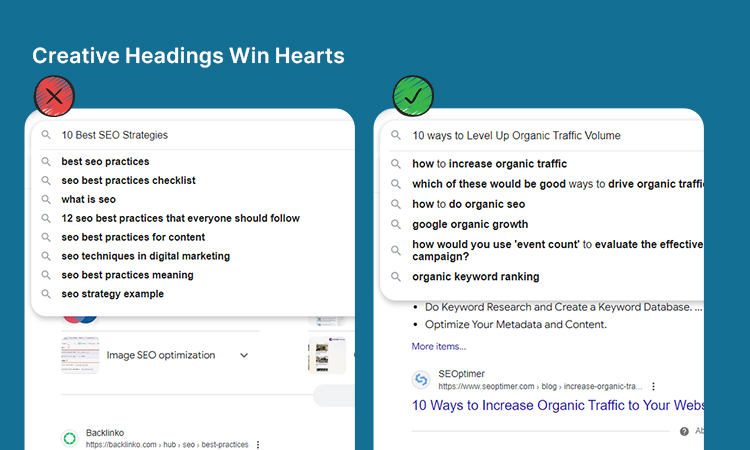
The headings play a significant role in attracting and retaining web traffic. Most internet users scan through content by reading the headings. It helps visitors segregate sections they want to read from those they don’t.
While writing content titles or headings, avoid monotony. Deviate from the stereotypical titles that they read everywhere. Keep the titles relevant, though. For example, instead of writing headings like ’10 Best SEO Strategies’, you can write ‘ 10 ways to Level Up Organic Traffic Volume’.
Also, segmentize the entire content into small parts. This is because no one wants to read chunks of texts today. Writing walls of text would only affect the bounce rate.
A creative heading might not cut it, as search engine optimization has a set of rules. For the sake of SEO, keep the heading under 60 characters, specifically the one for your content.
It helps users see the whole thing while using a mobile device. Otherwise, potential visitors can only read the heading halfway through.
Never skip on optimizing headings with H tags, as that is the only way to help search engines separate headings from the main content. Without these tags, your content is just a block of text to the web spiders!
Checklist For Writing Headings
- Write creative headings to boost the CTR (click-through rate)
- Use the appropriate H tag for each heading
- Keep the title tags under 60 characters
- Meta Descriptions Make a Difference
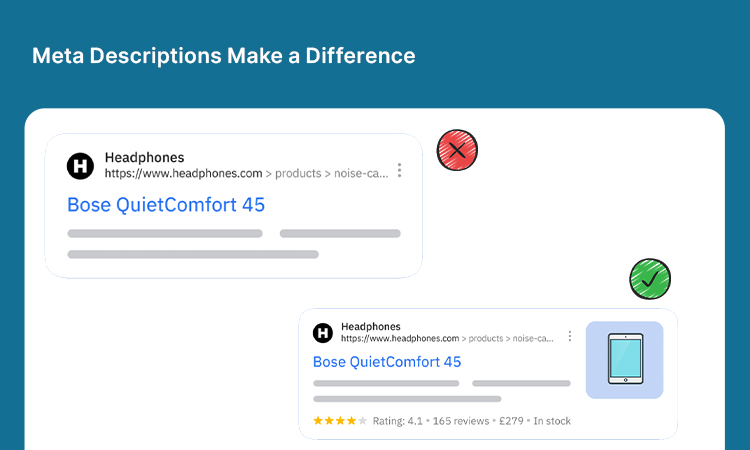
Meta descriptions are short snippets, usually under 160 characters, that give readers a gist regarding what the content is about.
Keeping it under a certain length helps mobile users view the entire meta description, which leads to higher footfall of organic traffic. It is much like the good old advertisements that precisely said what a specific product is about.
Crafting a keyword-rich meta description that strikes the right cord is one of the most powerful SEO strategies to boost the click-through rate. It attracts potential customers by telling them what a particular web page is about.
Checklist for Writing Meta Description
- Keep meta description under 160 characters
- Try including keyword(s) in the meta description
- Keep it relevant
- Highlight the content’s USP
- Google Likes Freshness: Update Website Content Regularly
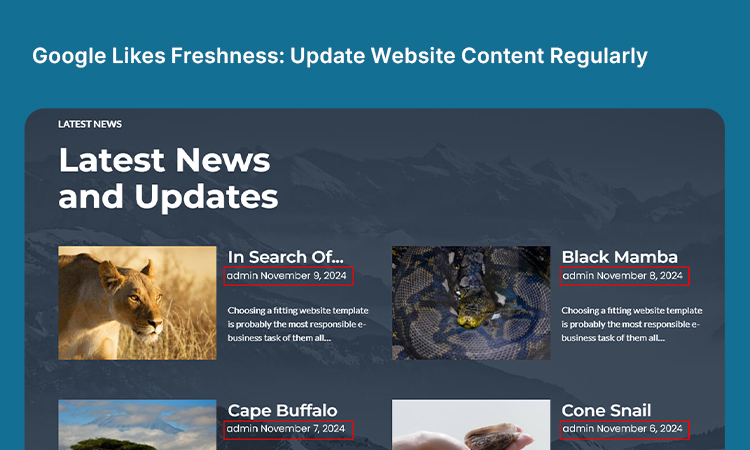
This is where most people managing SEO by themselves go wrong! Remember, SEO is an ongoing process. Updating content once in a while will help maintain the rank of your web pages or boost them to a higher ranking.
Updating content signals that the webpage contains the latest information that might be useful for the readers. It also gives an opportunity to the website owner to incorporate new information, statistics, and more with every content update.
Mentioning dates for ”first published” and ”last updated” can help your SEO efforts as it mentions content information clearly to the search engines.
While most content requires frequent updates, evergreen content on the other hand can be updated less frequently. Nonetheless, updating evergreen content is a necessary tool for maintaining quality and authority.
Checklist for Updating Content
- Add more content to the existing one
- Update internal and external links
- Consider including more LSI
- Update the meta description
- Update publish date
- Off Page SEO Strategies Help Get More Page Referral Traffic
While on-page SEO strategies work from the front, off-page strategies strengthen your website in the background. The aim of any off page strategy is two folds. First, it bolsters the domain authority and second, off page SEO optimization drives referral traffic to your website.
Let’s walk you through some of the important off-page strategies that bolsters any SEO campaign;
- Prioritize page Authority
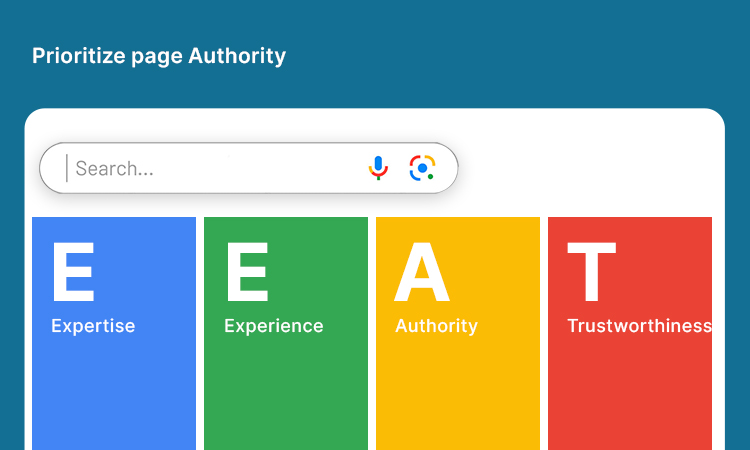
If content is King, then a backlink portfolio is the Queen!
Domain authority means everything in the field of SEO. Most content you see ranking on the first page of the search results has high domain authority.
Previously, it was mainly about keywords and their volume. However, with the introduction of Google E-E-A-T, domain authority means a lot. It is a core part of Google’s search quality rater guidelines.
Increasing domain authority is far from building a hasty backlink portfolio. It has a number of factors like Expertise, Experience, Authority, and Trustworthiness.
When you type a keyword, the link you will find ranking on the top of the SERPs is generally from a high authority domain. It is so because the top-ranking website demonstrates all quality signals of E-E-A-T.
When it comes to acquiring backlinks, keep it relevant to your domain. A hastily built backlink profile that consists of irrelevant or low-quality links can have either of these two results— a penguin penalty or a sharp drop in rankings.
Take time. Employ methods of natural link building that strengthen your website with higher trustworthiness. If you are new in the arena and don’t have a domain that ranks high enough for natural link-building, you can reach out to professional link building agency to help you bolster the backlink portfolio.
Checklist for Domain Authority Building
- Acquire relevant backlinks with high domain authority
- Take time with the natural link-building process
- Brand mention via social media
- Don’t Forget Directory Listing
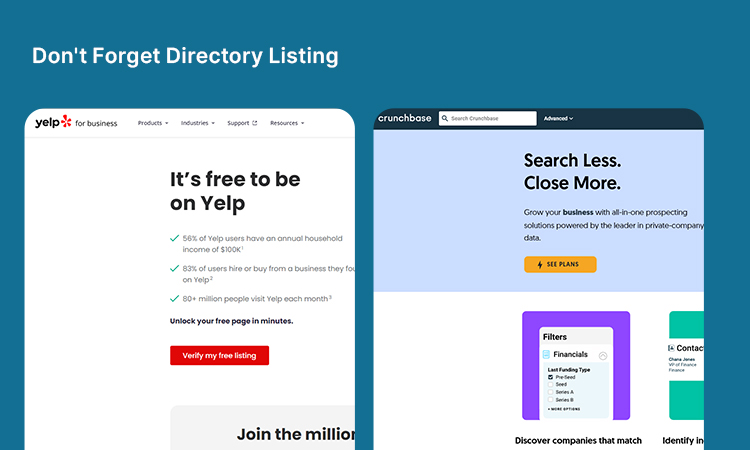
Directory listings are important irrespective of any geo targeting specifications. It helps potential customers discover your products or services. It is important for core information websites too.
Directory listings are one of the best SEO strategies. Not only does it help find new prospects, but it also generates natural links for your website, strengthening the EEAT signals. It is a cost effective solution that amplifies brand awareness, boosts sales and drives organic traffic to your website. Hence, you must definitely leverage large directories like Yelp and Yellow Pages.
Nonetheless, it does not end there. For niche specific websites, find directories specifically coded for your niche. Also, it is important to enlist your business NAP in the local directories to help local people discover your business if you are in their physical proximity.
Checklist for Directory Listings
- Enlist in all the major directories
- Update your correct NAP information
- Leverage local directories
- Maintain separate contact information if you are operating in more than one location
- Technical SEO Strategies: Enhance User Experience
Technical optimization helps websites get wired to offer a better user experience. It deters the occurrence of duplicate content with canonical tags, adjusts better to device screens, improves page speed, and improves website rankings.
Let’s take a peek at the different aspects of technical optimizations that form a part of search engine optimization.
- Start With a Website Audit
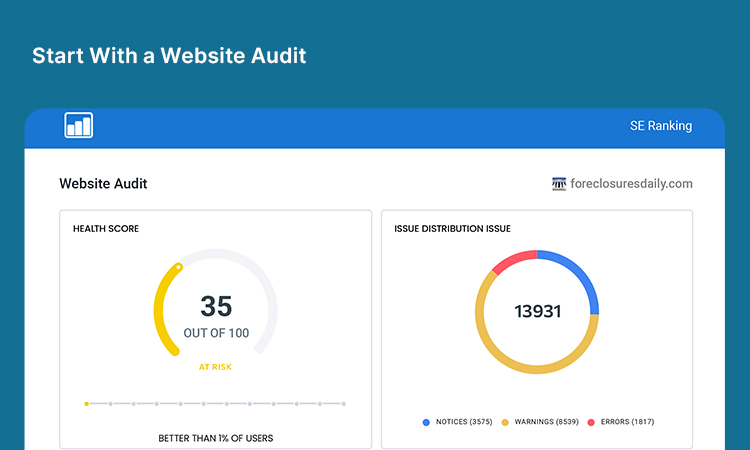
When you have a problem in your body, you run a few tests to know what’s wrong. You only take medicines after getting the results. A website is no different. It is vital to run a website audit in order to understand what’s going on with your SEO or why your website is not ranking,
A website audit points out all the underlying issues with your website. Google Analytics, Ahrefs, Screaming Frog, and Semrush are a few tools that can help you gather insights into your website’s SEO.
With the help of a website audit, you can find issues with the content, backlinks, broken links, page speed, etc. It will also give you a clear picture of user behavior, ranking keywords, etc.
Website Audit Checklist
- Get a full website report
- Identify the technical issues of your website
- Get to know the areas of improvement in the on-page SEO strategy
- Know the backlinks that are contributing to your website and disavow them
- Make Mobile Optimization a Priority
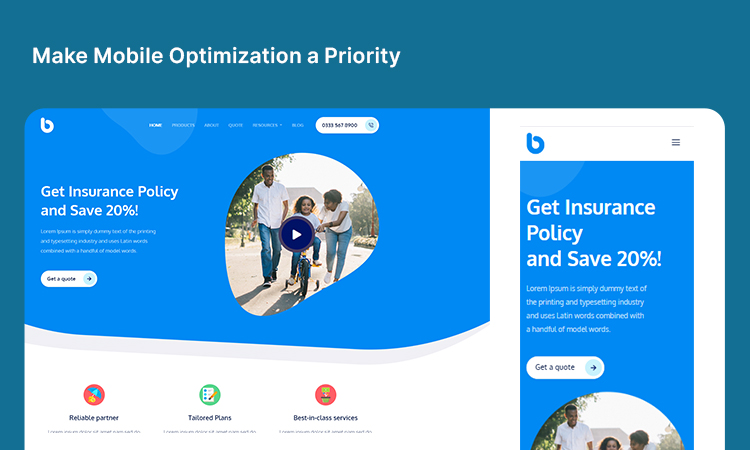
Mobile SEO optimization is super vital for two reasons. First, about 66% of internet users use mobile devices to access the internet. And Second, with Google’s mobile first indexation policy, you can’t rank your website well if you don’t have a good level of mobile communication backing up your website.
The easy way to optimize mobile SEO is to opt for a responsive website design. A responsive design will automatically adjust your website on every device.
However, you will not get many customization options in this front. The alternative to a responsive design is ‘adaptive website design.’ This type of website setup gives you full control over the layout but requires rigorous optimization.
If you are an SEO newbie, stick to the responsive design as it is easy. Nonetheless, if you are ardent about a well modulated website, you can certainly contact a website designing company to perform an efficient job.
Checklist for Mobile SEO Optimization
- Avoid intrusive pop ups
- Page speed optimization
- Image compression and placements
- Optimize website navigation
- Implement breadcrumb trail
- Heighten User Experience with Better Core Web Vitals
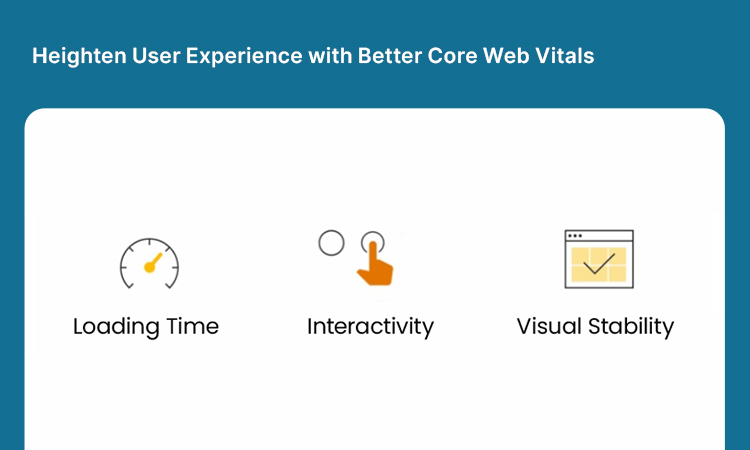
Part of technical optimization is to amp up user experience with better page loading, and for that, you need to keep a tab on the core web vitals of your website. Core web vitals consist of four measurements that ascertain the page speed of an URL.
The four measurements are;
- FCP – First Contentful Paint
- FID – First Input Delay
- LCP – Largest Contentful Paint
- CLS – Cumulative Layout Shift
FCP is the time taken by a website to load the first asset from the initial request. Having a lower FCP helps your website buy more time, as users generally wait a while before bouncing off when something is loaded.
LCP, on the other hand, is the time between the initial request and the loading of the last asset on the page.
FID, as a website performance indicator that denotes the time between an user’s input request and the server responding to the same. When you click on a certain link of a heavy website, you would see some choppiness.
You might want to load an image, but the website isn’t responding. It might not scroll down at your command because your device is busy doing other things in the background. This is what FID denotes.
Cumulative layout shift is the total shift of elements on a webpage from the first time it opens till it is loaded completely. Keeping a check on the core web vitals of your website means regulating the website for the best user experience.
Core Web Vitals Checklist
- Image compression
- Minify the Cascading style sheet for faster website loading
- Consider caching
- Preload fonts for quicker website speed
- Implement lazy loading
- Leverage Google Tools for Better Ranking
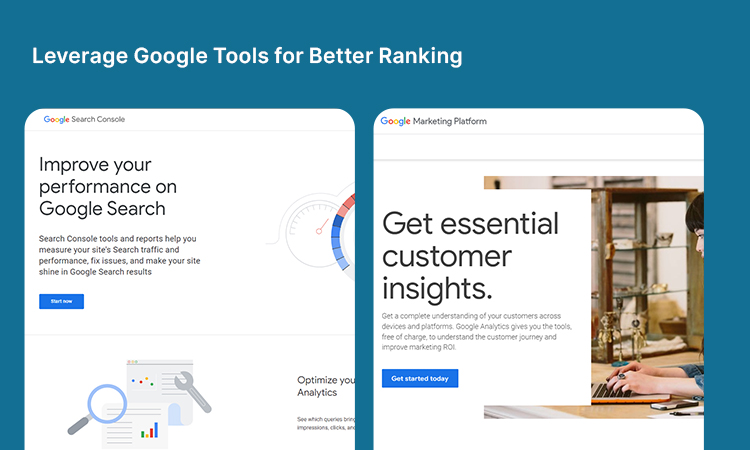
Often, people who are venturing into SEO are deterred from using premium tools because of their cost.
But, did you know that Google, the search engine giant, has already developed several tools for all who want top-notch website optimization? Well, Google offers an array of free tools. Although some of it is limited by monthly usage.
SEO tools like Google search console, Google analytics, Google Keyword Planner, Google Trends can help you chart up the search rankings.
Webmasters must leverage these tools to stay ahead of the curb. This is one of the best SEO strategies that can help you save money while delivering results at the same time.
Checklist of Must-Use Google Tools for Webmasters
- Google Search Console
- Google Analytics
- Google Lighthouse
- Google My Business (for local SEO optimization)
- PageSpeed Insights
- Google Data Studio
- Google Trends
- Optimize Website for Voice Search
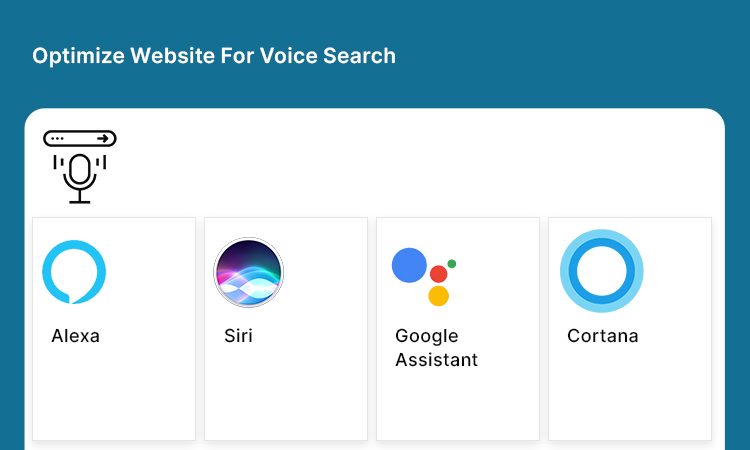
Voice search optimization is simply optimizing your website in a way so that it shows up on the search results when voice search assistants like Alexa, Siri, Google Assistant and Cortana search for specific search queries that match your website.
Voice search optimization is often one of the most neglected SEO strategies that must not be overlooked. It caters to users who are impatient, and use voicing instead of typing their search queries.
It lets you target long tail question keywords and give you a solid competitive edge. Hence knowing how to optimize for Google voice search is crucial.
Checklist for Voice Search Optimization
- Conducting keyword research for voice optimization
- Understand user intent and compare it against your competitors
- get the technical optimization right
- Answer user questions
- Monitor Website SEO for Better Results
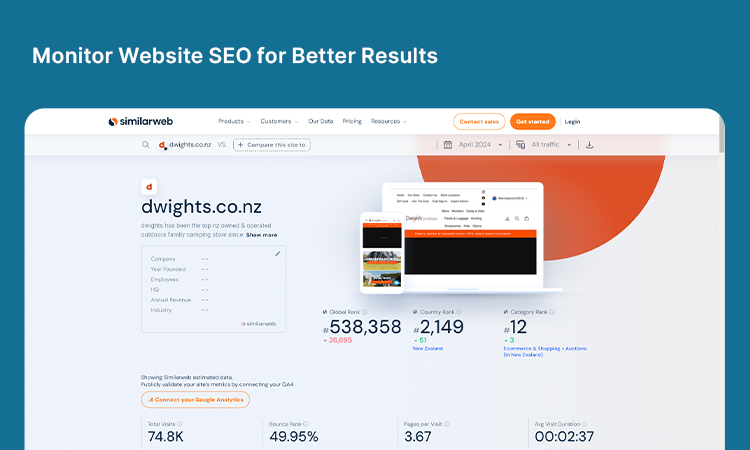
The main reason why many SEO campaigns fail is because of a lack of monitoring. Analyzing and monitoring takes time, and with people focusing on their core business, they often lack the time for it. If you want to succeed in the digital realm, we suggest you take out time for your website. It will bear fruits in the end.
Run a technical audit every once in a while. Also, keep an eye on the Google search console to check for any issues. If you detect an issue, take action immediately, and you should be fine.
Should you see a sharp drop in the ranks on the search engine results or problems with page indexation, then you have incurred a penalty. You can contact Google penalty recovery services to redeem yourself.
Website monitoring and analysis also offer insightful data that can help you formulate stronger SEO strategies in the future. You can gain information on which keywords are ranking, the source of website traffic, conversion rate, and many more.
It also gives you a detailed view on the links that are working for your website and the ones that you should disavow to maintain the health of your website.
Website Maintenance Checklist
- Run website audit
- Update content regularly
- Monitor website uptime
- review meta tags and descriptions
- Keep up with Google algorithm updates
5 Advanced SEO Strategies for Smart Webmasters
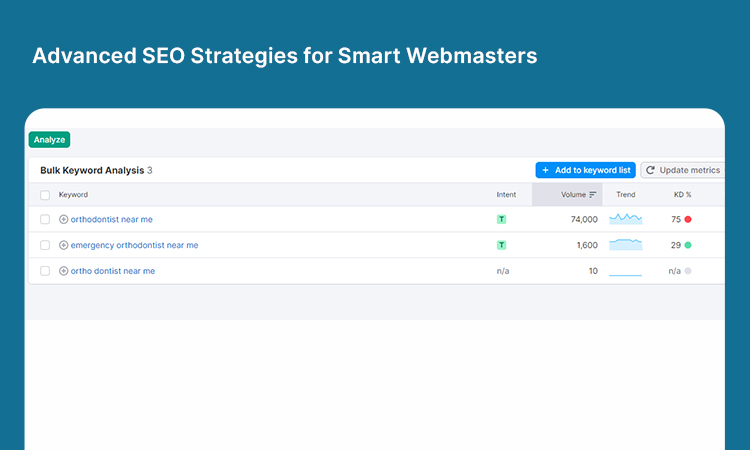
Every digital marketer is after SEO! Each one of them wants their website to rank at the top of the Search engine results.
But why? Why is search engine optimization so important to everyone?
Well, because SEO drives 1000% more traffic than organic social media does! The number also beats the percentage of traffic generated through paid search.
Hence, because of the immense competition, sticking to the basic SEO practices might not suffice. You need to get out of the line and do something solid to become the favorite of the search engines.
Now that we have discussed the basic SEO strategies for newbies, we shall move a step ahead and delve into some advanced SEO practices. You can implement these practices with some SEO knowledge or hire SEO company for them.
- Emulate Ranking Websites
Before brainstorming what will work for the search engines, look at which web pages the search engines are ranking.
Research your competitors’ websites and see which web pages are ranking at the top. Once you have enough data, DO THE SAME! Yes, you read that right. This is not called stealing; you are simply looking at your competitors’ SEO strategies and creating something similar or better for yourself that search engines might like better.
Search for patterns that give you the answer to why they are doing well. Research your things about your competitor’s website, like;
- keywords they are targeting
- Is their content short-form or long-form?
- Do they have a separate section for blog post?
- Are they using images, videos, or infographics?
- Do they have an SEO performance strategy?
Once you have enough insights, create a solid SEO campaign by building your competitors’ strategies that surpass them! Of course, you will need premium research tools, ample time, and expert guidance to get the search traffic you want. But it is worth it!
- Adapt to Google’s Algorithm Changes
It is no secret that Google’s search algorithm keeps changing. However, its workings are a mystery to all, which makes SEO optimization all the more interesting and harder to do.
The link builders and keyword targeters have faced a major setback, as Google keeps high-quality content at the center of the ranking factor. Other things to keep in mind are Google RankBrain and EEAT signals.
Of course, you will still need a good backlink profile as PageRank continues to be a part of the core algorithm in 2024. Your backlink portfolio should have ample inbound links pointing to your website and internal links to reach the SERPs’ top.
Pay heed to technical SEO for a better user experience, as content cannot be the carrier alone. It needs additional support to help your website beat its competitors.
- Find Opportunities in Your Competitor’s Weaknesses (Build on Their Broken Links)
Broken links are links that redirect a user to a 404 page. These links simply offer bad experiences that internet users do not want to incur. To build on your competitor’s broken links, you have to run a website audit first.
Simply put your competitor’s URL in any premium technical audit tool and click on Run. This should lead you to a list of all the indexed pages and broken links pointing to the website.
Each of these dead links is an opportunity you must seize! Building links based on it can garner amazing results. All you have to do is approach the webmasters for each of these sites, craft content of better quality and offer to post them.
Once you post these content with solid anchor texts, you shall be able to bolster your own backlink portfolio.
- Target Topic Clusters
Google wants to deliver the best experience to its users. For this, it ranks pages that are informative, easy to navigate, and have topical expertise. This is what targeting topic clusters can help you achieve.
Topic clusters are a group of topics that are related to each other. In other words, each of the topics will update the reader on the previous topic and enlighten on the next one.
A typical SEO cluster consists of three things: an umbrella topic, subtopics, and internal linking between them.
For example we are talking about SEO Strategy in this blog. So this is our umbrella topic. We can create an SEO cluster by writing individual blog posts on topics like Content marketing, backlink building, social media marketing, mobile SEO, etc. and link each other to form a relevant cluster.
Users reading one blog can easily navigate to the other one to find more information on a topic without disruption.
- Optimize the Website for the PAA Box
Google search results have become more advanced than they used to be back in time. It is more than the typical blue links that you see.
The PAA box stands for People Also Asked Box. It is a google search results feature that displays additional information on a topic in the form of questions. It generally a set of 3 to 4 questions. But with a single click on the dropdown tab, 2 to 3 more questions are added to it every time.
You can follow popular platforms like Quora, or Reddit to know what people are talking about. Another great way to find PAA questions is by following Google Trends. It can help you understand the current trends, burning topic of discussions and search volume for each topic.
Remember to be precise and to the point with your answers, as this particular SEO strategy can help you rank twice on the Google search results.
FAQs
Some of the effective SEO strategies that work for every SEO practitioner are keyword research, content optimization, social media marketing, mobile SEO optimization, and monitoring websites. These are basic strategies that never disappoint. However, if you want more organic traffic or want to drive to the top of the SERPs, you might want some more advanced strategies along the way.
The time an SEO campaign might take depends on an array of factors such as the competitiveness of the target keywords, domain authority, backlink portfolio, presence of any Google penalties, etc. Hence, the time varies from one website to another. A general bracket for SEO to fetch results would be between one month to six months.
Resorting to ethical SEO practices bears no risk. It can take time, depending on your SEO strategy, but there is no terror factor associated with it.
However, black hat SEO practices like keyword stuffing, low-quality link acquisition, and cloaking put your website in trouble. It can lead to a sharp drop in ranking, an algorithmic penalty, or blacklisting of your website. Hence, it is advisable to stick to white hat SEO practices for SEO success in a risk-free way.
SEO typically does not cost much. You should be able to optimize the basic factors of your websites for free. However, taking a subscription to premium tools for better optimization can come at a cost. Also, if you are getting help from any SEO agency, that will add to the bill.
If you are looking for the right SEO companies, always consider factors like market experience, client portfolio, success rate and budget before hiring. Another important aspect in this regard is online reviews and market reputation of the SEO company.
Wrapping Up
Website optimization is not only about uploading content. An effective SEO strategy does not stand alone in on-page optimization. You have to solidify it with other factors like link building, technical optimization, and time-to-time monitoring.
Ranking on Google search is not an easy-peasy deal! Given the tough competition, you might face quite a few challenges, especially if you are doing it on your own. But worry not; over time, you can learn the ropes and master them! However, if you want quicker results, you can hire an SEO services agency to gear up your website SEO. They have tried and tested SEO strategies up their sleeves to help your website gain traction on the search rankings.
Additional Resources:
- Why Is SEO Important to a Business?
- All About SEO Pricing: How Much Does SEO Cost?
- 15 Daily Tasks in a Comprehensive SEO Routine for 2024


